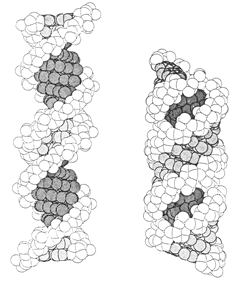
|
|
||||||||
Some Secrets of Life
Structural Mechanics in Molecular Biology
The study of bacteria and DNA is not usually associated with engineering, but Professor Chris Calladine has applied his knowledge of structural mechanics in solving some fundamental problems in this area. It all started with wondering how the corkscrew shaped tails (flagellae) of bacteria, which act as tiny propellers, can possibly be constructed from a set of single identical building blocks - the protein flagellin - since identical building blocks in a tubular packing can normally build only straight rods.
|
See the following page for simplified models. |
Calladine addressed this fundamental question in some pioneering work with Aaron Klug, of the MRC Laboratory of Molecular Biology, in 1975. He showed that if the flagellin molecule contained just one "mechanical" bi-stable switching feature, then he could explain not only the construction of a corkscrew as such, but also the known ability of that corkscrew to change into a variety of other helical forms in different physical circumstances. In principle, an assembly of identical three-dimensional mechanically bistable subunits can show surprising and subtle structural forms; and this feature is brilliantly exploited in nature.
Once it had become clear that the principles of structural mechanics could be used to answer such questions at a microscopic scale, Calladine developed a further collaboration with Horace Drew, also of the MRC Laboratory, to answer fundamental questions regarding the structure of DNA.
